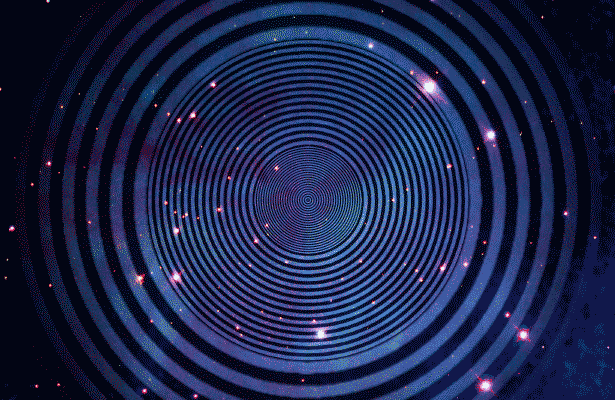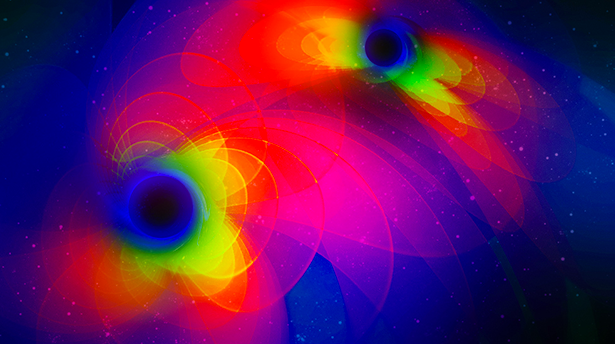Is Infinity Real?

Euclidean geometry has a way of turning mathematically inclined students into lifelong math lovers, and I was no exception. But a primitive assumption has always troubled me: The definition of a “geometric point” refers to something that has position, but no dimensions, so there can be an infinite number of them in any given line segment. While you can imagine such a thing in the abstract world of mathematics, it cannot be realized at a physical level by a real-world object.
When we see the multitude of reflections in two parallel mirrors, we loosely say that it goes on forever, but in reality the images get smaller and smaller. At some physical limit, the image information is lost: We are all familiar with the pixelation in digital images.
Mathematicians have developed the theory of infinity to an exquisite degree — Georg Cantor’s concept of transfinite numbers is notable for its beauty, “a tower of infinities with no connection to physical reality,” as Natalie Wolchover put it in a recent Quanta article on the finite-infinite divide in mathematics. Infinities implicitly pervade many familiar mathematical concepts, such as the idea of points as mentioned above, the idea of the continuum, and the concept of infinitesimals in calculus. But can infinities truly exist in any aspect of the physical world? Is space truly infinite, as some inflationary models of the universe assert, or is it in some way “pixelated” at the lowest level? In an extremely interesting book, This Idea Must Die, in which many eminent thinkers describe scientific ideas they consider wrong-headed, the physicist Max Tegmark of the Massachusetts Institute of Technology argues that it is time to banish infinity from physics. While “most physicists and mathematicians have become so enamored with infinity that they rarely question it,” Tegmark writes, infinity is just “an extremely convenient approximation for which we haven’t discovered convenient alternatives.” Tegmark believes that we need to discover the infinity-free equations describing the true laws of physics.
We don’t have to examine the foundations of physics to see examples of how the infinity assumption can give qualitative answers that are not quite correct in the real world. In many cases, better or at least more useful answers can be obtained if we just stick to very large or very small quantities. Here are three puzzles that illustrate this. In these examples, do not get stuck on practical details. Focus on how the theoretical answers change when you discard the notion of infinity.
1. Can a number that is finite but very large substitute for infinity?
This first question is just a warm-up to show how we can replace infinitistic thinking with finitistic thinking. It concerns the famous Hilbert’s Hotel, an idea introduced by David Hilbert in 1924.
Consider a hypothetical hotel with a countably infinite number of rooms, all of which are occupied. Can it accommodate 1,000 new guests without increasing the number of guests in any of the occupied rooms? If you had a finite number of rooms, the pigeonhole principle would apply. In this context, this common sense principle says that you cannot have n+1 pigeons in n holes if there is only room for one pigeon in each hole. But in an infinite hotel, it’s easy! We just move every resident from his or her room n to room n + 1,000. Voilà! Rooms one to 1,000 are now empty!
Notice the sleight of hand involved in using infinity in this way. This solution cannot work with a finite number of rooms, no matter how large. Let us restrict ourselves to the notion that the number of rooms can be as large as the size of the universe allows, but must be finite. Can the question still be answered positively? Well, it turns out that you can easily accommodate 1,000 new guests in a finite physical hotel that is currently full. And the arrangement will take less time than moving a single person from one room to another. All it takes is the reasonable assumption that there is a tiny, nonzero probability of a person checking out within a given time. Let’s assume, conservatively, that the probability of a guest checking out on a given day is one in a hundred. Can you see how the hotel can put up its additional guests?
2. What if there are physical limits to the smallest measurable amount of space?
It is a theorem of plane geometry that the sum of the lengths of any two sides of a triangle is greater than the length of the third. But what if there is a physical limit to the smallest length of space that is measurable, say somewhere close to the Planck limit of 1.6 x 10-35 meters? Will this theorem of geometry still hold near that length?
Let us substitute a less daunting but still microscopic length for the Planck length. Imagine that the laws of physics prevent you from measuring anything smaller than 0.001 micron. Can you have a triangle on the plane that has sides measuring 100, 200 and 300 microns? Can such a triangle, which you would expect to be impossibly flat, have a measurable area? Can you go further and have a triangle that has a sum of two sides that measures smaller than the length of the third side? The answers may surprise you.
3. How sharp is a geometric focus in the real world?
Consider the case of an elliptical billiard or pool table. An ellipse is a geometric figure that has two foci. Any straight line drawn from one focus to the circumference of the ellipse is reflected to the other focus. Now assume you have a pool table with a pocket at one focus. If you place the ball at the other focus, it shouldn’t matter what direction you hit it — it should still land in the pocket. Right?
Here is a video by The Guardian’s puzzle columnist, Alex Bellos, who had such a table built by one of the best billiard-table makers in Britain.
Alex Bellos
The physical table is not perfect in manufacture, of course, but let us assume that it is. There is still the problem that the mathematical focus is a dimensionless point, whereas the ball, being a physical object, has a finite size. How does this finite size affect how accurately the ball goes to the other focus when hit? Given this, and the fact that no pool player is perfect, will you get equally good results no matter which direction you hit the ball as long as it is at a focus initially? If the major axis of the table is 2 meters in length and the minor axis is 1 meter, what is the best direction to hit the ball from one focus so that it bounces and rolls into the pocket at the other focus? Assume the pocket is about 1.5 times the diameter of the ball. Will your conclusion change if the ball and pocket are made as small as physically possible without changing their relative sizes?
Happy puzzling! I hope these questions give you new insights about the contrast between infinity in mathematics and the physical world.
Editor’s note: The reader who submits the most interesting, creative or insightful solution (as judged by the columnist) in the comments section will receive a Quanta Magazine T-shirt. And if you’d like to suggest a favorite puzzle for a future Insights column, submit it as a comment below, clearly marked “NEW PUZZLE SUGGESTION” (it will not appear online, so solutions to the puzzle above should be submitted separately).
Note that we will hold comments for the first day or two to allow for independent contributions.
Update: The solution has been published here.



